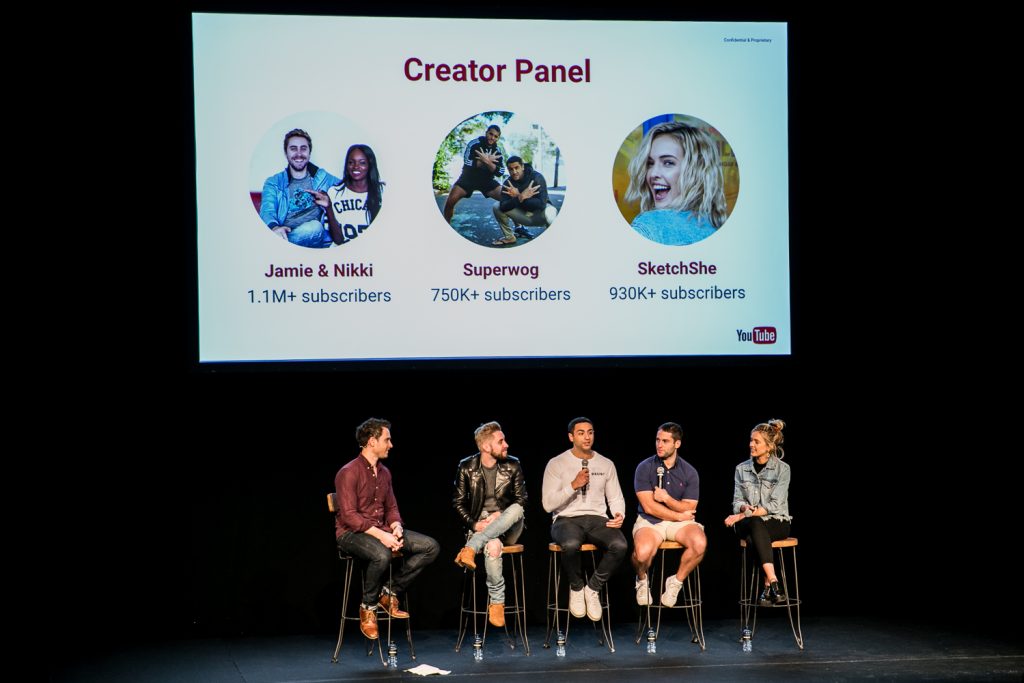These YouTube Stars Let Us In On The Secrets To Their Success

What do you do, if you’re a small-scale YouTube creator, and you’re offered a lucrative content partnership with KFC?
If you’re Superwog, an Aussie sketch-comedy duo comprised of two brothers and a camera, the answer is simple: turn it down.
“It just wasn’t authentic to our comedy,” they told the crowd at Video Junkee 2017. Don’t get them wrong — the brothers love KFC — but when they read the ideas pitched by the brand, things just didn’t mesh with what Superwog was building. At the end of the day, they didn’t want to compromise their own fledgling brand.
“Especially for some drumstick,” they told Video Junkee, to laughs.
This is just one of the surprising pieces of advice shared by YouTube creators at a panel today on making content for YouTube in 2017. The audience heard a bunch of tips from Superwog, as well as Lana Kington from acclaimed all-woman sketch comedy trio SketchShe, and Jamie, one half of young-couple-turned-popular-lifestyle-vloggers Jamie & Nikki.
If you couldn’t make the panel in person, though, don’t stress — here are a few of the most surprising takeaway lessons for making it big on YouTube today.
Know When To Turn Brands Down

Superwog weren’t the only panellists in favour of turning down some sweet opportunities to make some cash. All the panellists agreed that while sponsorship deals and partnerships with brands are important as far as making a living from YouTube, it’s crucial to make sure collaborations with brands are authentic.
Jamie of Jamie & Nikki said that their audience will “absolutely roast us” when they sense the pair are promoting a brand they don’t really connect with.
The idea, Jamie says, is to think about the long run — YouTube audiences feel much more personally connected to creators than audiences of traditional video content, so building an audience requires building trust. It does mean that progress towards making actual money is slower, but the payoff is a fanbase that will follow you as your content evolves over time.
Start Scrappy, And Build From There
YouTube is a very different place now to what it was five or more years ago, when today’s viral content makers were just getting started. For one, production values are much slicker — the big dogs today have moved away from grainy webcam vids in favour of nice lenses and boom mics.
But do you need a fancy camera to get started on YouTube today? Today’s panel were unanimous: absolutely not.
It comes back down to what Lana from SketchShe refer to as the “slow burn” of YouTube — audiences want to feel attached to creators, and want to grow with them.
“We were making videos for two years until we found our voice,” she said, emphasising how important that period of experimenting and building up a back catalogue was for finding an audience and growing with them.
Jamie’s experience was similar. “I think people really enjoy watching the journey,” he said. “People actually relate sometimes more to content that isn’t overly polished”.
It’s that relationship that’s important to get viewers on board. Once you start building that connection, the panel said, the slick cameras and cool effects will come later.
Get Creative With What You’ve Got
Starting small doesn’t necessarily mean sticking to the grainy vlog format, though. With just a phone and a bit of thought, there’s a lot you can do to try to make your video style stand out.
For sketch groups like Superwog and SketchShe, that might mean seeking out collaborators, or staying on the lookout for behind the scenes and process content to supplement the main show. It also means spending time thinking about the best locations to film, and other ways to create visual interest.
“The industry calls it pre-production,” Superwog said, “but we’re just like ‘shit, man, where are we gonna film this thing?”
For an unscripted lifestyle vlog like Jamie & Nikki, the creative process can mean coming up with innovative ways to break up the to-camera vlogging with more visually interesting stuff.
“We’re always working out ways to film b-roll on the fly,” Jamie said, screening an example of a vlog he interspersed with drone footage and landscape shots that built up a narrative about the world around him.
Don’t Try To Go Viral
Most importantly, though, everything about YouTube success comes back to the audience. The panel’s creators all warned against trying to go viral — hits are transient, they said, while your audience lasts.
Rather than aiming for virality, they said, the most important thing is consistency — uploading regularly, taking time to interact with an audience, and trying to “create habits with your audience” that will help to slowly build a group that keeps coming back.
“We’d rather have a community than a viewership,” Jamie said. Viral hits fade, and new viewers leave. But the YouTube community? They’re the ones that will always be there.